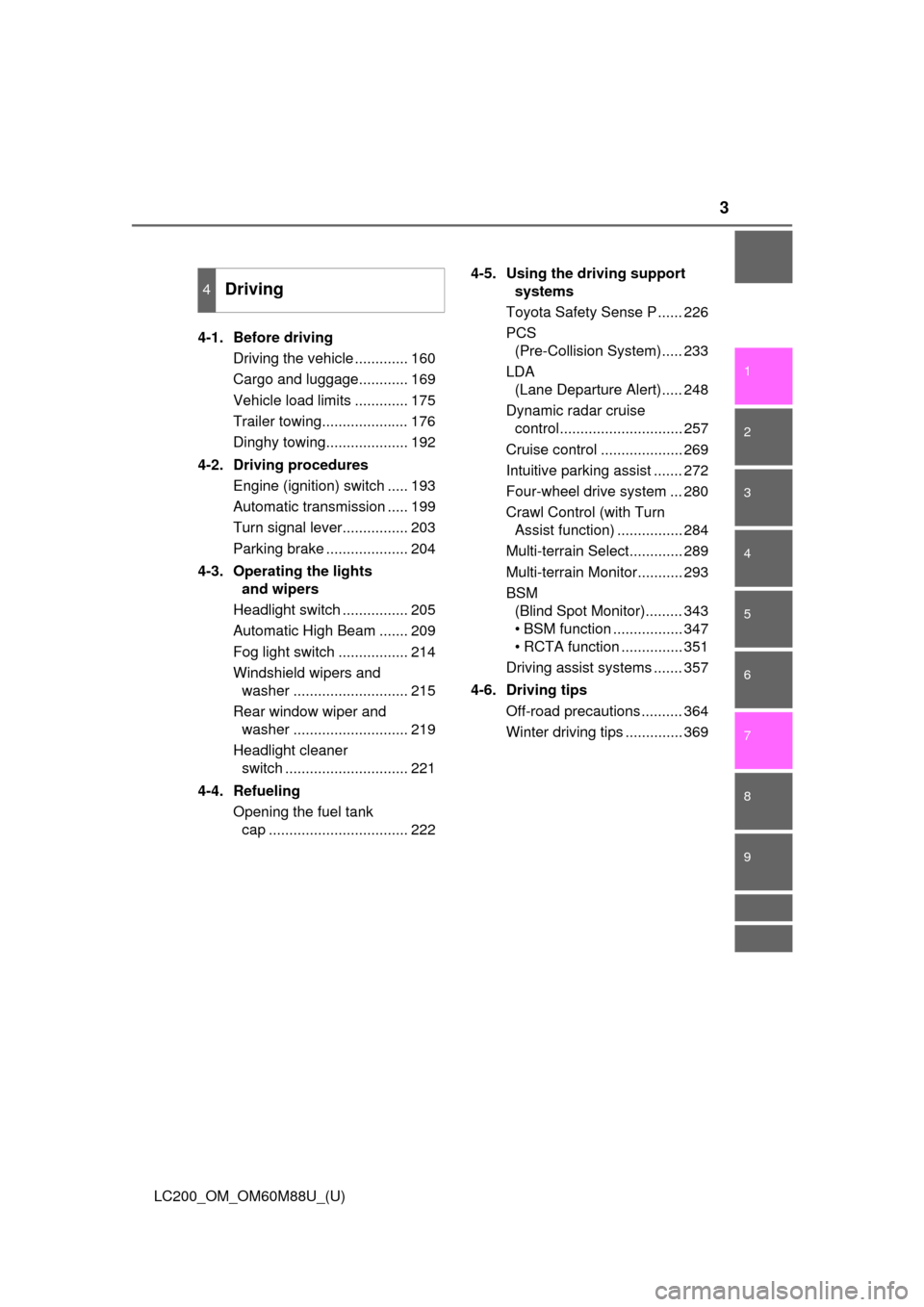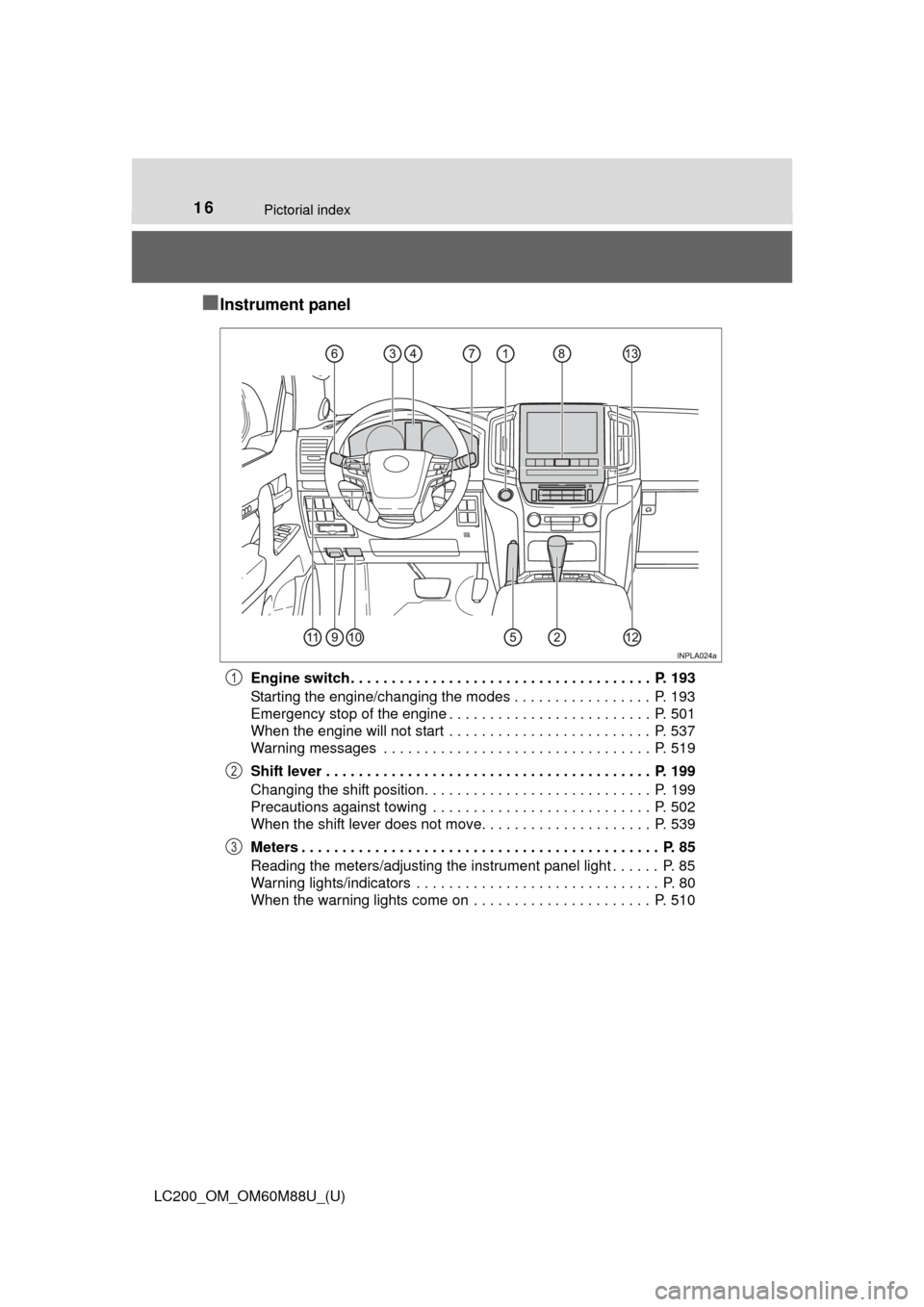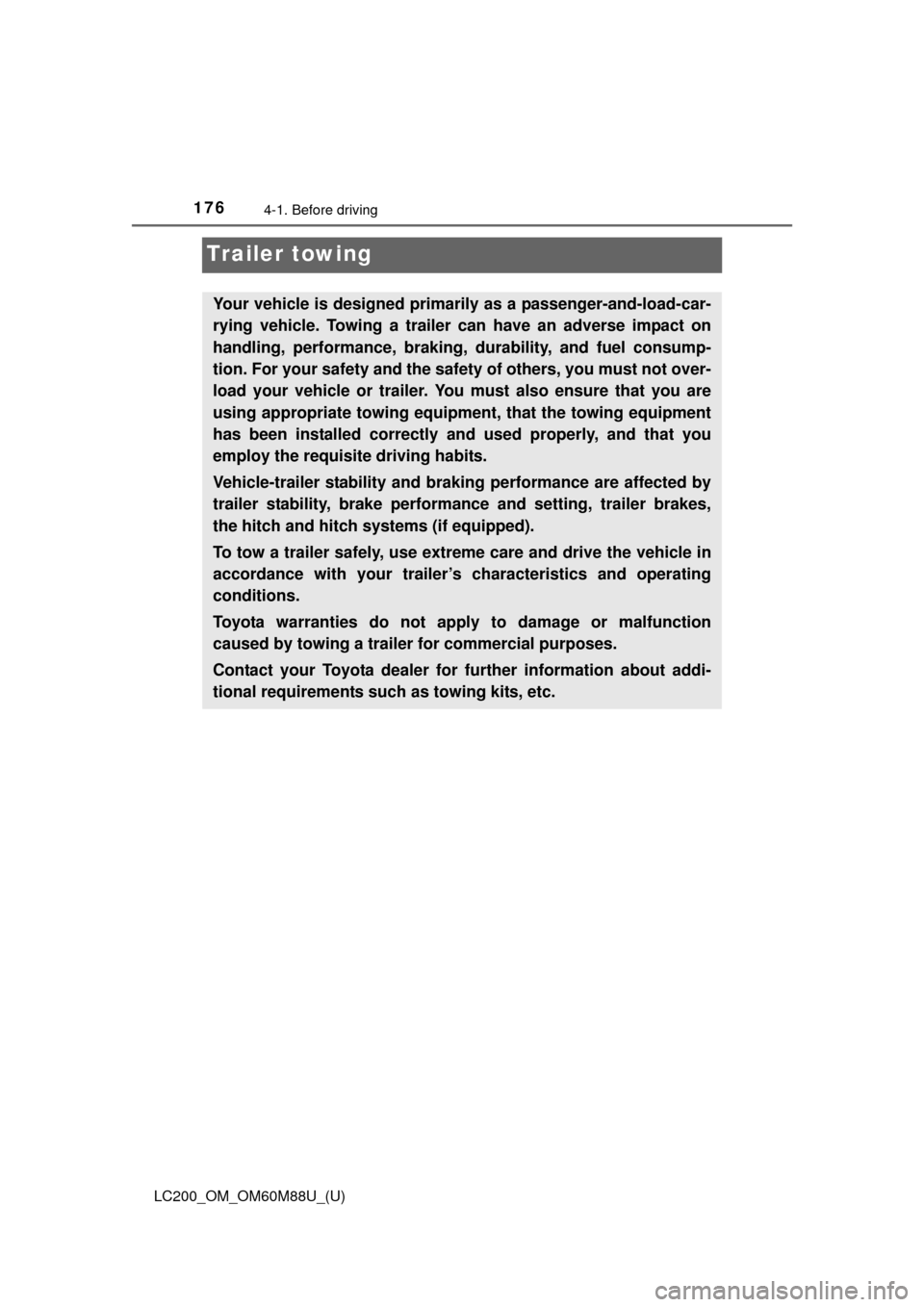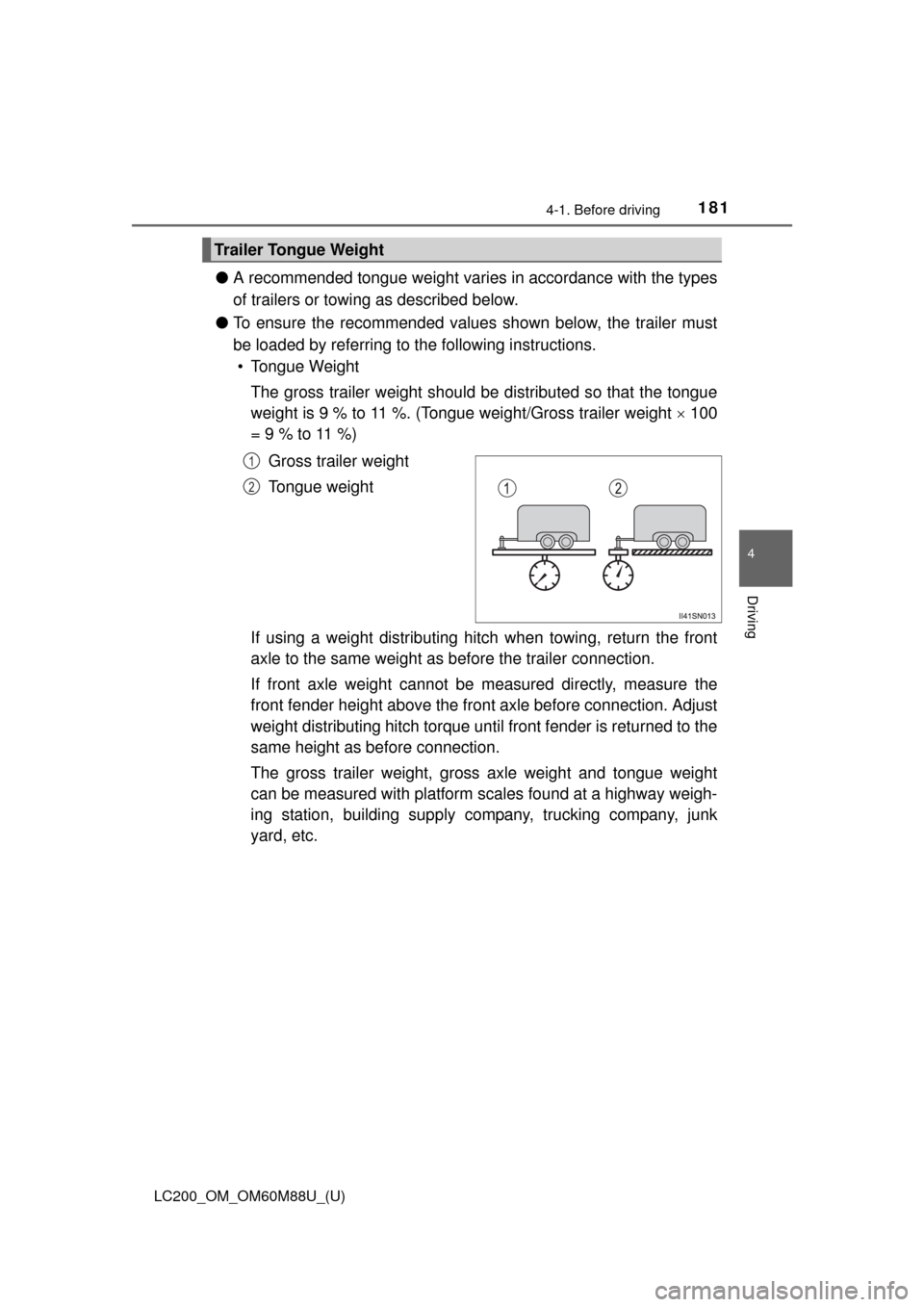Page 3 of 608

3
1
8 7
6
5
4
3
2
LC200_OM_OM60M88U_(U)
9
4-1. Before drivingDriving the vehicle ............. 160
Cargo and luggage............ 169
Vehicle load limits ............. 175
Trailer towing..................... 176
Dinghy towing.................... 192
4-2. Driving procedures Engine (ignition) switch ..... 193
Automatic transmission ..... 199
Turn signal lever................ 203
Parking brake .................... 204
4-3. Operating the lights and wipers
Headlight switch ................ 205
Automatic High Beam ....... 209
Fog light switch ................. 214
Windshield wipers and washer ............................ 215
Rear window wiper and washer ............................ 219
Headlight cleaner switch .............................. 221
4-4. Refueling Opening the fuel tank cap .................................. 222 4-5. Using the driving support
systems
Toyota Safety Sense P ...... 226
PCS (Pre-Collision System)..... 233
LDA (Lane Departure Alert)..... 248
Dynamic radar cruise control.............................. 257
Cruise control .................... 269
Intuitive parking assist ....... 272
Four-wheel drive system ... 280
Crawl Control (with Turn Assist function) ................ 284
Multi-terrain Select............. 289
Multi-terrain Monitor........... 293
BSM (Blind Spot Monitor)......... 343
• BSM function ................. 347
• RCTA function ............... 351
Driving assist systems ....... 357
4-6. Driving tips Off-road precautions .......... 364
Winter driving tips .............. 369
4Driving
Page 16 of 608

16Pictorial index
LC200_OM_OM60M88U_(U)
■Instrument panel
Engine switch. . . . . . . . . . . . . . . . . . . . . . . . . . . . . . . . . . . . . P. 193
Starting the engine/changing the modes . . . . . . . . . . . . . . . . . P. 193
Emergency stop of the engine . . . . . . . . . . . . . . . . . . . . . . . . . P. 501
When the engine will not start . . . . . . . . . . . . . . . . . . . . . . . . . P. 537
Warning messages . . . . . . . . . . . . . . . . . . . . . . . . . . . . . . . . . P. 519
Shift lever . . . . . . . . . . . . . . . . . . . . . . . . . . . . . . . . . . . . . . . . P. 199
Changing the shift position. . . . . . . . . . . . . . . . . . . . . . . . . . . . P. 199
Precautions against towing . . . . . . . . . . . . . . . . . . . . . . . . . . . P. 502
When the shift lever does not move. . . . . . . . . . . . . . . . . . . . . P. 539
Meters . . . . . . . . . . . . . . . . . . . . . . . . . . . . . . . . . . . . . . . . . . . . P. 85
Reading the meters/adjusting the instrument panel light . . . . . . P. 85
Warning lights/indicators . . . . . . . . . . . . . . . . . . . . . . . . . . . . . . P. 80
When the warning lights come on . . . . . . . . . . . . . . . . . . . . . . P. 5101
2
3
Page 159 of 608

159
LC200_OM_OM60M88U_(U)
4Driving
4-1. Before drivingDriving the vehicle ............. 160
Cargo and luggage ........... 169
Vehicle load limits ............. 175
Trailer towing..................... 176
Dinghy towing ................... 192
4-2. Driving procedures Engine (ignition) switch ..... 193
Automatic transmission ..... 199
Turn signal lever................ 203
Parking brake .................... 204
4-3. Operating the lights and wipers
Headlight switch ................ 205
Automatic High Beam ....... 209
Fog light switch ................. 214
Windshield wipers and washer ............................ 215
Rear window wiper and washer ............................ 219
Headlight cleaner switch .............................. 221
4-4. Refueling Opening the fuel tank cap .................................. 222 4-5. Using the driving support
systems
Toyota Safety Sense P ..... 226
PCS (Pre-Collision system) ..... 233
LDA (Lane Departure Alert) .... 248
Dynamic radar cruise control ............................. 257
Cruise control .................... 269
Intuitive parking assist....... 272
Four-wheel drive system ... 280
Crawl Control (with Turn Assist function) ............... 284
Multi-terrain Select ............ 289
Multi-terrain Monitor .......... 293
BSM (Blind Spot Monitor) ........ 343
• BSM function ................ 347
• RCTA function .............. 351
Driving assist systems ...... 357
4-6. Driving tips Off-road precautions ......... 364
Winter driving tips ............. 369
Page 170 of 608

170
LC200_OM_OM60M88U_(U)
4-1. Before driving
Cargo capacity depends on the total weight of the occupants.
(Cargo capacity) = (Total load capacity) (Total weight of occupants)
Steps for Determining Correct Load Limit
(1) Locate the statement “The combined weight of occupants and cargo should never exceed XXX kg or XXX lbs.” on your vehicle’s
placard.
(2) Determine the combined weight of the driver and passengers that will be riding in your vehicle.
(3) Subtract the combined weight of the driver and passengers from
XXX kg or XXX lbs.
(4) The resulting figure equals the available amount of cargo and lug- gage load capacity.
For example, if the “ XXX” amount equals 1400 lbs. and there will be
five 150 lb passengers in your v ehicle, the amount of available
cargo and luggage load capacity is 650 lbs. (1400 750 (5150) =
650 lbs.)
(5) Determine the combined weight of luggage and cargo being loaded on the vehicle. That weight ma y not safely exceed the available
cargo and luggage load capacity calculated in Step 4.
(6) If your vehicle will be towing a tr ailer, load from your trailer will be
transferred to your vehicle. Consult this manual to determine how
this reduces the available cargo and luggage load capacity of your
vehicle. ( P. 175)
Capacity and distribution
Page 176 of 608

176
LC200_OM_OM60M88U_(U)
4-1. Before driving
Trailer towing
Your vehicle is designed primarily as a passenger-and-load-car-
rying vehicle. Towing a trailer can have an adverse impact on
handling, performance, braking, durability, and fuel consump-
tion. For your safety and the safe ty of others, you must not over-
load your vehicle or trailer. You must also ensure that you are
using appropriate towing equipmen t, that the towing equipment
has been installed correctly a nd used properly, and that you
employ the requisite driving habits.
Vehicle-trailer stability and braking performance are affected by
trailer stability, brake performance and setting, trailer brakes,
the hitch and hitch systems (if equipped).
To tow a trailer safely, use extreme care and drive the vehicle in
accordance with your trailer’s characteristics and operating
conditions.
Toyota warranties do not apply to damage or malfunction
caused by towing a trailer for commercial purposes.
Contact your Toyota dealer for further information about addi-
tional requirements such as towing kits, etc.
Page 177 of 608
LC200_OM_OM60M88U_(U)
1774-1. Before driving
4
Driving
■GCWR (Gross Combination Weight Rating)
The maximum allowable gross
combination weight. The gross
combination weight is the sum
of the total vehicle weight
(including the occupants, cargo
and any optional equipment
installed on the vehicle) and the
weight of the trailer being towed
(including the cargo in the
trailer).
■GVWR (Gross Vehicle Weight Rating)
The maximum allowable gross
vehicle weight. The gross vehi-
cle weight is the total weight of
the vehicle. When towing a
trailer, it is the sum of the vehi-
cle weight (including the occu-
pants, cargo and any optional
equipment installed on the vehi-
cle) and the tongue weight.
Towing related terms
Page 178 of 608
178
LC200_OM_OM60M88U_(U)
4-1. Before driving
■GAWR (Gross Axle Weight Rating)
The maximum allowable gross
axle weight. The gross axle
weight is the load placed on
each axle (front and rear).
■TWR (Trailer Weight Rating)
The maximum allowable gross
trailer weight. The gross trailer
weight is the sum of the trailer
weight and the weight of the
cargo in the trailer.
TWR is calculated assuming
base vehicle with one driver,
one front passenger, towing
package (if available), hitch and
hitch systems (if required).
Additional optional equipment, passengers and cargo in the vehicle will
reduce the trailer weight rating so as not to exceed GCWR, GVWR and
GAWR.
If the gross trailer weight exceeds 3000 lb. (1360 kg), it is recommended
to use a trailer with 2 or more axles.
Front GAWRRear GAWR
(With brakes)
Page 181 of 608

LC200_OM_OM60M88U_(U)
1814-1. Before driving
4
Driving
●A recommended tongue weight varies in accordance with the types
of trailers or towing as described below.
● To ensure the recommended values shown below, the trailer must
be loaded by referring to the following instructions.
• Tongue Weight
The gross trailer weight should be distributed so that the tongue
weight is 9 % to 11 %. (Tongue weight/Gross trailer weight 100
= 9 % to 11 %)
Gross trailer weight
Tongue weight
If using a weight distributing hitch when towing, return the front
axle to the same weight as before the trailer connection.
If front axle weight cannot be measured directly, measure the
front fender height above the front axle before connection. Adjust
weight distributing hitch torque until front fender is returned to the
same height as before connection.
The gross trailer weight, gross axle weight and tongue weight
can be measured with platform scales found at a highway weigh-
ing station, building supply company, trucking company, junk
yard, etc.
Trailer Tongue Weight
1
2